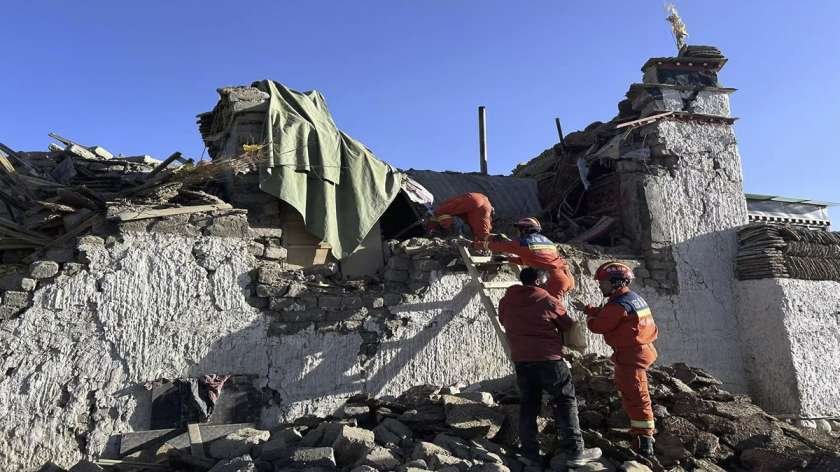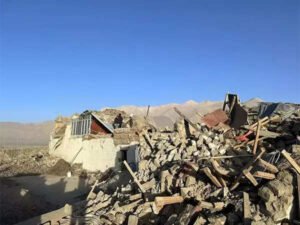You may have heard of the recent shallow 5.7 magnitude earthquake that hit Tibet recently, making its inhabitants and geologists concerned about the nation’s seismic activity. The shallow earthquake measured 5.7 on the Richter scale, powerful enough to send alarm but mercifully not cataclysmic in effect.
The earthquake rattled the ground along a large geological fault line, pointing again to the active character of this seismically active zone. When these happen in Tibet’s remote parts, they often remind us anew of the dynamic forces that work ceaselessly around the clock reshaping our Earth under our very feet.
Shallow 5.7 Magnitude Earthquake: Understanding What Happened
You should be aware that this earthquake occurred in Tibet, which is located in what experts call a seismically active area. The quake had a magnitude of 5.7, which is classified as moderate earthquake strength. Such quakes have the potential to damage poorly built structures but are seldom responsible for extensive destruction.
What is especially remarkable about this event is that it has a shallow depth. When earthquakes are near the Earth’s surface, their energy loses less before hitting the ground, meaning individuals experience the shaking more forcefully than comparable magnitude quakes deeper in the ground.
The fault line on which this tremor took place is part of the larger system developed by the collision between the Indian and Eurasian tectonic plates. This colossal collision of continental masses commenced around fifty million years ago and continues to the present day, thrusting upward to create the Himalayan mountain range and Tibetan Plateau.
Shallow 5.7 Magnitude Earthquake: Impact on Local Communities
You may ask what the impact of this earthquake was on those residing in the area. Though details are scarce, early accounts indicate little damage to buildings and no serious casualties reported. The far-off locations of most Tibetan settlements tend to leave fewer tall buildings and fewer people per area, and that helps decrease the impact of lesser earthquakes.
Local governments, in all probability, enacted routine emergency procedures after the event. These would involve immediate actions on the assessment of key structures like dams, bridges, power stations, and primary highways to guarantee public safety is safeguarded following the cessation of the ground movement.
People in locations nearest the epicenter would have felt intense shaking, potentially knocking objects off shelves and producing slight damage to structures. People further away may have felt gentle swaying or vibrations for several seconds.
Scientific Significance
You may learn a lot from observing these seismic events. Scientists monitor each of these tremors in this area with keen interest since each gives useful information regarding the process going on in this segment of Asia.
Scientists send out networks of highly sensitive equipment across Tibet and adjacent regions to monitor tectonic activity. These instruments capture very accurate measurements to assist experts in gaining better insights into the mechanism of how stress accumulates and releases on fault lines.
This specific earthquake provides yet another bit of information on the complicated puzzle of how the colossal collision of India with Eurasia still remakes the landscape. Every episode contributes to our understanding of future earthquake hazard possibilities and assists in enhancing building codes and safety protocols.
Shallow 5.7 Magnitude Earthquake: Historical Context of Seismic Activity
You should bear in mind that Tibet has seen many earthquakes throughout history. The area is situated on top of what geologists call one of the most seismically active areas on Earth, formed by the continuous collision between continents that started millions of years ago.
Strong earthquakes have hit different regions of Tibet and its environs over the last few decades. In 2015, a devastating 7.8 magnitude earthquake struck neighboring Nepal killed almost 9,000 people and left everything in shambles. Another powerful tremor of 6.9 also hit Tibet’s Nyingchi region in 2017, but its isolation curtailed casualties.
These happen along various sections of the same gigantic fault system. Each energy release relieves some of the accumulated tectonic stress, but also possibly shifts pressure to other parts of the fault line, which may cause future earthquakes elsewhere.
Safety Considerations for Residents and Travelers
You may want to consider safety if you reside in or will be traveling to seismically active areas such as Tibet. Experts advise some simple precautions that can really help increase your likelihood of staying safe in the event of an earthquake.
First, anchor heavy appliances and furniture to keep them from tipping over during shaking. Store emergency items in ready supply, such as water, non-perishable foods, flashlights, and first-aid supplies. During an earthquake, use the “drop, cover, and hold” routine – drop to the ground, take cover under a sturdy piece of furniture, and hold on until the shaking has stopped.
Tourists can study earthquake emergency procedures prior to arrival in areas such as Tibet and heed local guidance at all times in times of crisis. Understanding evacuation routes from your guesthouse or hotel may save your life in extreme circumstances.
Shallow 5.7 Magnitude Earthquake: Monitoring and Future Outlook
You may see more monitoring activity in the area after this event. Seismologists routinely send extra instruments following moderate earthquakes to measure aftershocks, which yield useful information regarding subsurface conditions and patterns of stress.
These aftershocks,are smaller earthquakes that occur after the initial earthquake. Usually happens for days or weeks later. While generally weaker than the original quake. They sometimes cause further damage, particularly to buildings already damaged by the original event.
Although scientists cannot accurately forecast when earthquakes will happen, their increasing knowledge of seismic trends enables them to identify locations at greater risk. This information guides building codes, infrastructure development, and emergency planning throughout the Tibetan region.
The recent 5.7 earthquake is another vital reminder that it takes respect for nature’s power and appropriate preparedness for the impact of her forces to survive and live on our changing Earth. Every event, we gain further knowledge about how to live safely with Earth’s energetic geologic processes.








Be First to Comment